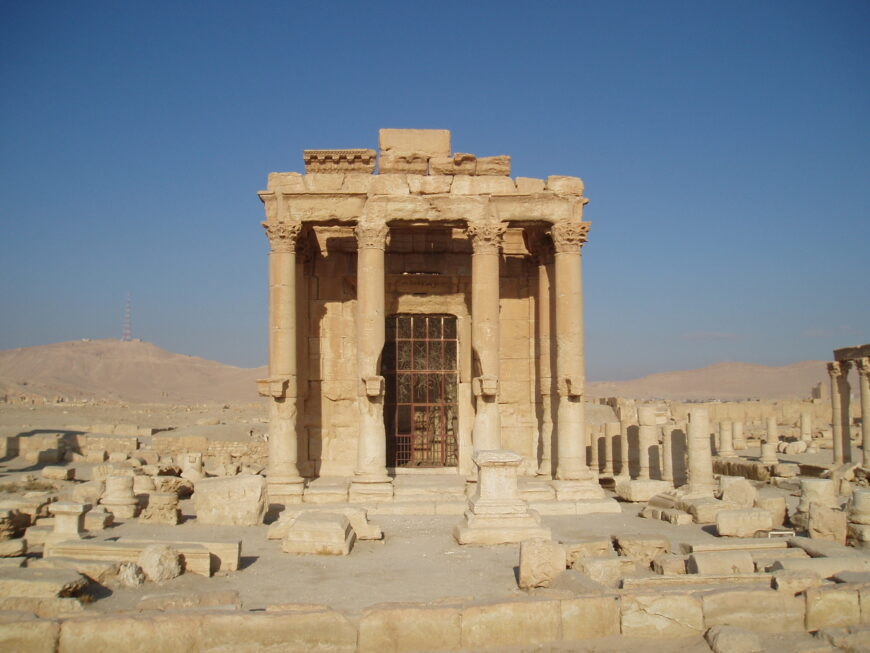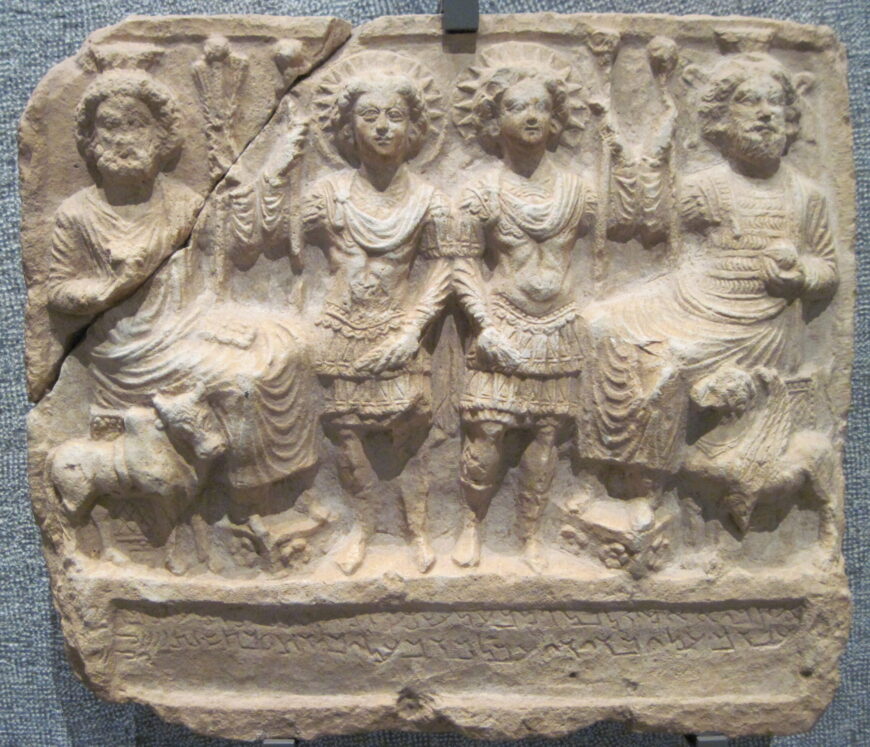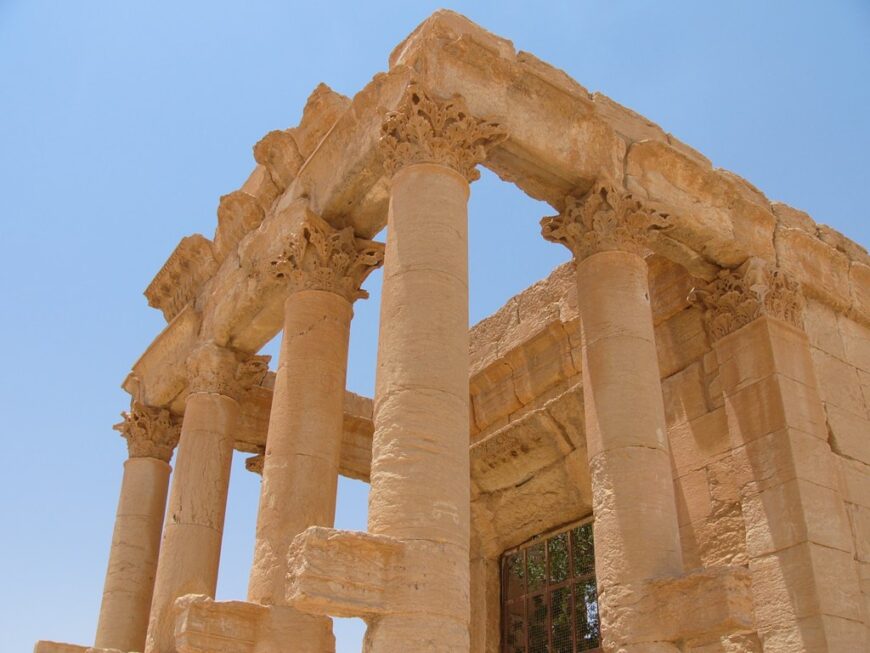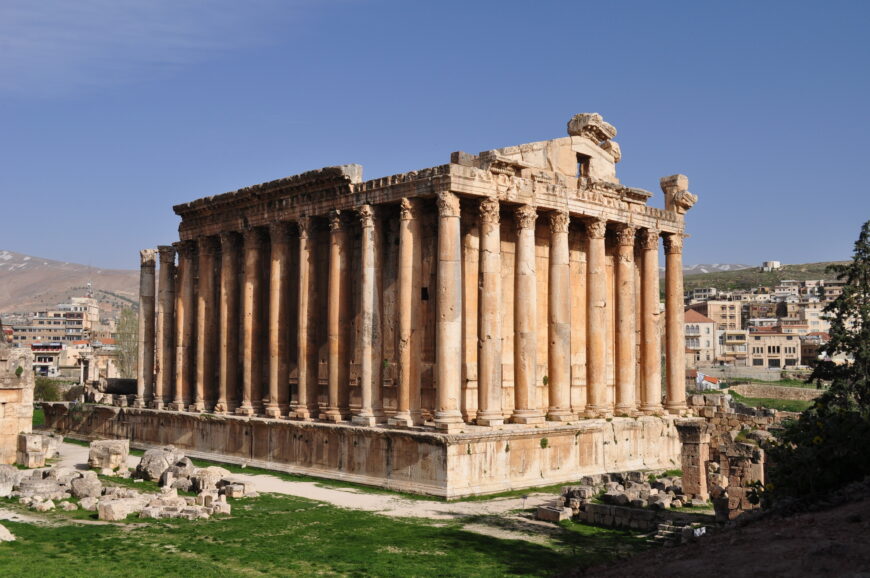
Temple of Baalshamin, 1st century C.E. (Palmyra—in modern Syria) (photo: E.jaser)
Hybrid in design
The Temple of Baalshamin in Palmyra was a 1st century C.E. sanctuary dedicated to one of the key gods of the city. [1] As with other Palmyrene architecture, the sanctuary of Baalshamin demonstrated hybridity of design—incorporating both Near Eastern and Graeco-Roman elements.
The cult
The temple’s cult is dedicated to Baalshamin or Ba’al Šamem, a northwest Semitic divinity. The name Baalshamin is applied to various divinities at different periods in time, but most often to Hadad, also known simply as Ba’al. Along with Bel, Baalshamin was one of the two main divinities of pre-Islamic Palmyra in Syria and was a sky god. The relief plaque below depicts a votive dedication by a worshipper—Baalshamin and Bel along with Yarhibol and Aglibol.

Limestone bas-relief dedicated by Ba’alay to Bel, Baalshamin, Yarhibol, and Aglibol. Limestone, dated January 121 CE., from Palmyra (Museum of Fine Arts, Lyon; photo: Owen Cook, CC BY-SA 3.0)
The architecture
The temple of Baalshamin was a prostyle, tetrastyle temple of the Corinthian order with a deep porch.
The temple was set within a colonnaded precinct. The temple building dated to c. 130 C.E. and represents an addition to a sanctuary that already existed by 17 C.E.

View of the porch with free-standing columns, and a pilaster visible on the flank, Temple of Baalshamin, 1st century C.E. (Palmyra—in modern Syria) (photo: Juan Llanos, CC BY-ND 2.0)
The temple itself is conventional in its external design, meaning it conforms to what one would expect from a Classical Graeco-Roman structure. The four freestanding columns across the façade are complemented by engaged pilasters at the sides and back.

Temple of Baalshamin, 1st century C.E. (Palmyra—in modern Syria) (photo: Paul Kidd, CC BY-NC-SA 2.0)
The colonnaded precinct experienced several phases of development during the 1st century C.E. (prior to the addition of the current temple). By the time of the temple’s construction, the colonnade had become a so-called Rhodian peristyle. The complex continued to develop across the course of the 2nd century.
The temple itself adopts a Near Eastern motif of including a window in each of the cella’s flanks, a trait that is not Graeco-Roman but that finds comparison in contemporary temples in Lebanon. These windows reflect the belief that the divinity dwelled in the temple.

Temple of Bacchus in Baalbek (now in Lebanon) (photo: Caroline Granycome, CC BY-SA 2.0)
Context
The Temple of Baalshamin in Palmyra is a rough contemporary of the Temple of Bacchus in Baalbek (now in Lebanon). Although dissimilar in scale (the Temple of Bacchus is a monumental building), both show the contemporary propensity in Roman provincial architecture of using forecourts to frame sanctuaries, as well as showing the widespread use of the Corinthian order. This is one of a number of sanctuaries in the city that demonstrates the great wealth of the Palmyrenes. Palmyra and much of the Roman Near East was rich in cultural diversity, a diversity expressed in many ways, including by means of art and architecture.
Notes:
[1] The Temple of Baalshamin was destroyed in 2015.
Additional resources
Palmyra Temple Was Destroyed by ISIS, U.N. Confirms—New York Times
Palmyra’s Baalshamin temple ‘blown up by IS’—BBC News
Images taken from Robert Wood’s The Ruins of Palmyra, London, 1753
UNESCO World Heritage List: Site of Palmyra
Palmyra on The Metropolitan Museum of Art’s Heilbrunn Timeline of Art History
Palmyra photo album on Flickr from the Institute for the Study of the Ancient World
More about Baalbek on Unesco’s webpage
Paul Collart, “Reconstruction Du Thalamos Du Temple De Baalshamîn a Palmyre,” Revue Archéologique, Nouvelle Série, fasciculus 2 (1970), pp. 323–27.
Klaus Schnädelbach, Topographia Palmyrena (Documents d’archéologie syrienne; 18) (Damascus: République arabe syrienne, 2010).
Andrew M. Smith II, Roman Palmyra: Identity, Community, and State Formation (New York: Oxford University Press, 2013).
Jean Starcky and Michel Gawlikowski, Palmyre (Paris: Librairie d’Amérique et d’Orient, 1985).
John Bryan Ward-Perkins, Roman Imperial Architecture (New Haven: Yale University Press, 1981).

